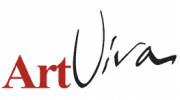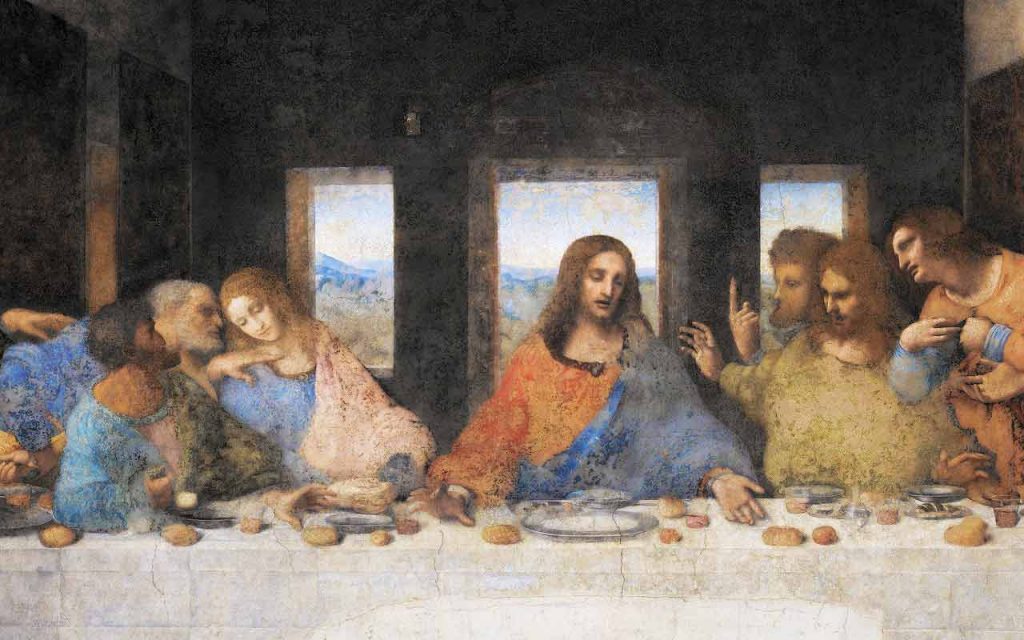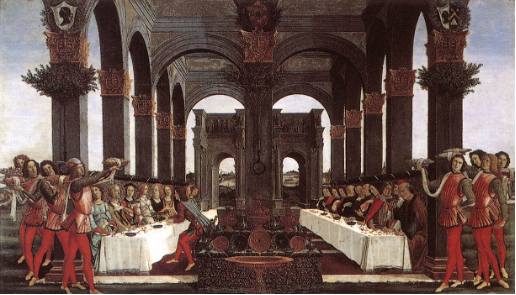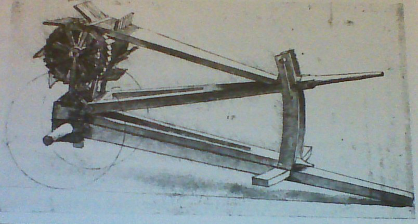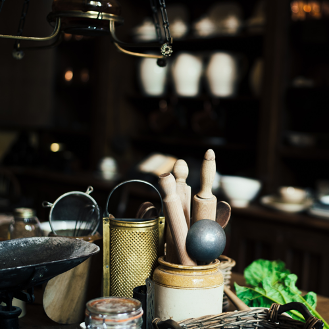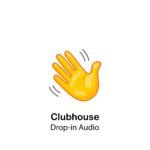Say Leonardo da Vinci and thought goes to the enigmatic smile of the Mona Lisa, to the Vitruvian Man, the breath taking Last Supper, or the cryptic mirror-script hand written notes. But who knew that Leonardo probably invented the first vertical spit roaster ever? And that he developed a recipe for a refreshing drink? Have you ever thought about following Leonardo’s dietary recommendations? Well, if you are a fellow foodie, here is the reading of the day.
The Birth of a Foodie
Born in 1452 in the small town of Vinci, on the hillsides between Florence and Pisa, Leonardo da Vinci began his life as the illegitimate son of a notary and a peasant woman called Caterina. Luckily for him, his father took him into great consideration and helped him to find his own professional path in Florence. Leonardo was very talented in art and joined very young the famous workshop of Andrea del Verrocchio; with him, other young artists destined to become very famous, like Domenico del Ghirlandaio, Sandro Botticelli and Pietro Perugino. Truth is that Leonardo was much more than just an artist; his talents and fields of interests were literally endless and he is now rightly considered one of the greatest mind of the Renaissance.
Leonardo, the man who wanted to fly, the polymath, artist, inventor, architect, musician, sculptor, engineer, anatomist became a celebrated artist during his lifetime but his creative genius and incredibly ahead of times technological inventiveness was not fully recognized until hundreds of years after his death. When Leonardo died in 1519 in France, he left all of his manuscripts and drawings to his favorite student Francesco Melzi. Apparently, he left almost 120 complete notebooks to Melzi, but only twenty-eight of them survived. In fact, when Melzi died in 1570, Leonardo had been almost forgotten, most of his projects never realized. Leonardo Da Vinci used to write mirror-script and this odd habit might have made it difficult to read his notes. Melzi sold many of the notebooks and many other people had access to Leonardo’s work, often making their own notes on top of his. Only in the 16th century, did scholars begin to collect and literally cut and paste all the manuscripts into big collections called Codex.
Looking at his notes and projects and reading his thoughts we might think that he was coming from the future; like the protagonist of a steampunk novel, his actions seemed like belonging to another era. Many of his ideas have actually been realized many years – sometimes centuries – later, probably not even knowing that he had invented them first.
Leonardo was a good old Tuscan guy, and when we think about Tuscany we immediately think about food, wine, oil. Isn’t it true that in every movie we see that involves Tuscany, people are either talking about food or eating food and drinking wine? Cheese and prosciutto trays, slices of fragrant bread and a glass of wine on a side makes the perfect setting for everything Tuscan in the common imagination but we must admit that this is not that far from reality. Tuscany is actually a real land of foodies and we could say that it’s always been like that. Here is where Leonardo fed his mind, dipping his bread in the pungent, fruity Tuscan oil.
The Taste of the Renaissance
The Renaissance was for Florence an incredible moment of cultural and artistic blossoming that involved also the kitchen. Being a rich city of merchants, Florence was the crossroads of many things, including exotic spices, foods and treatises on gastronomy and the philosophy of nutrition.
Rich families used to throw memorable banquets, challenging one another to organize the most unforgettable one. On the tables, three or more tablecloths overlap to bear the usually one-day-long feasting around the table. More the 20 courses would be served and the smell of the spices surrounded the guests. The more spices one could use the richer he was; a nutmeg could cost like 12 cows!
The Renaissance marks also the birth of wine culture; the wine as something to appreciate by itself, and carefully choosing the right food to pair it with, was a completely new idea. With the invention of typography on 1456 – the same year of Leonardo’s birth – cookbooks could be printed out and sold all around the world; it’s the birth of gastronomy. We know for sure Leonardo owned what is considered to be the first printed cookbook, On Right Pleasure and Good Health, written by the famous “gastronomy guru”, chef, scholar and nutritionist Bartolomeo Sacchi, known as Platina and it’s easy to imagine that Leonardo – always eager to learn and discover new things, to be stimulated by different cultures and ideas -, got involved by this Renaissance “foodie” vibe.
Leonardo Da Vinci in Milan: Kitchen Designer?
When in 1482, at the age of thirty, Leonardo moved from Florence to Milan and joined the court of Ludovico Sforza, the duke of Milan, he was hired not as a court artist – as you reasonably may expect – but as an entertainer, musician, event planner, court architect and designer of war machines. So, during his stay in Milan – in addition to creating masterworks like The Last Supper – Leonardo was busy remodeling the Sforza castle, home of the Duke of Milan, and planning unforgettable parties for the court’s most important celebrations.
Within all the projects for the castle, he thought about the kitchen, too, and he was thinking big – and different – as usual. The ideal kitchen he had in mind was very modern and within all the incredible innovations he designed, especially in terms of workflow, he invented something that still nowadays is essential in every restaurant of the world: the service window. He wrote: “food from the kitchen may be served through wide, low windows, or on tables that turn on swivels”.
Amazing visionary inventor, Leonardo had always in mind the idea of saving human efforts and this idea would apply very well into a Renaissance kitchen. In the 15the century the pantagruelian banquets would need in fact an incredible physical effort in the kitchen.
Leonardo Da Vinci: King of the BBQ
Let’s try and imagine how to spit-roast a piglet when nothing was automatic; you would need a dedicated person to sit in front of the fire and rotate the spit over and over until the meat was perfectly, evenly roasted. It took time and human fatigue. Why waste all this time, thought Leonardo, if you can design a completely automatic device to turn the meat on a spit over the fire using a propeller activated by the power of heated air? A propeller? The power of heated air? In the 1400’s?
Look at the picture above; the heated air would rise into a chimney, activating a turbine that would turn the gears connected to the spit over the fire. “The roast will turn slow or fast depending on whether the fire is small or strong”, notes Leonardo. Unbelievable. He invented Shawarma and put the basis for the helicopter, all at once…
Always obsessed by the idea of better control and utilize the cooking fire both for safety and for a better, faster, way of cooking that could work without the constant human work, Leonardo invented what some sources believe is the first barbecue unit. Have you ever thought about Leonardo da Vinci while enjoying a cook out with your family and friends? Because probably you should have. His ideas put the basis for almost all of our barbecues. The food place on a grate and the wood in the bottom through an opening that had two functions; to help the air inside and keep the fire going. Actually nobody knows if any of these inventions were actually constructed. Many kitchen tools of very common use are frequently attributed to Leonardo; the most common of all is probably the garlic squeezer. Did you know that sometimes this particular gadget is nicknamed “Leonardo” by professional chefs?
Leonardo’s Larder and Other Kitchen Stories
What did Leonardo’s daily table look like, though? The Codex Atlanticus contain also some notes on Leonardo’s grocery shopping and we can make quite a clear idea about that. First of all, in contrast to the elaborate court feasts he was organizing for the Sforza family, he used to serve himself and his assistants very modest meals, with an eye on simplicity and on the quality of the ingredients, like the good old Tuscan guy he was.
Very little veal, poultry, fish and cheese on Leonardo’s grocery shopping notes. Curiously pitted fruit, root and tubers of any kind never occurred on the lists together with olive oil, pasta, unless he made his own. Recurrent ingredients are buttermilk and eggs; eggs were considered by Platina a cure for “cough, sore windpipes, a hoarse voice, and those spitting spitting blood.” The only fruits that are not listed in a generic form are melon and grapes: again Platina wrote that melon “soothes the stomach and gently softens the bowels” and grapes “are less unhealthy than other fruits which are eaten raw.” Fruit always seen under a certain suspicion.
Leonardo liked mushrooms cooked with garlic; still a staple in the Italian kitchen. Garlic was taught to have the power of counteracting the potential mushroom’s poison. In his list we can find bread and flour and millet, which were common ingredients for peasant’s soups. Spices – common ingredients on Renaissance tables – are listed too; mint, thyme, parsley, nutmeg, mustard, buckwheat, and pepper. In culinary essays of the time we find mint mentioned as a medicine for the hearth and the stomach, also “effective against the bite of a rabid dog”; parsley roots (not leaves) “act wonderfully against poison,” and nutmeg “settles vomit, and induces appetite by soothing the stomach and liver.”
Kidney beans and peas appear frequently on the lists and the word “vegetables” and “salad” are used in a generic sense.
Vinegar, sugar and wine are the other three ingredients always on the list. Leonardo appreciated wine and frequently wrote on his notebook about the different wines he could taste during his trips around the region. Like a modern wine-blogger he informs us about prices, different tastes and colors and different food to pair the wines with.
By reading his shopping lists, it’s easy to assume that Leonardo was interested in the healing power of food and was probably following a specific dietary philosophy; a diet that is incredibly similar to contemporary longevity diets, indeed.
How to Make the Da Vinci Drink
In one of the pages of the Codex Atlanticus – probably the most important collection of Leonardo’s personal notes, sketches and drawings – we can find the recipe of a drink called Acquarosa (rose water): water, sugar, rose petals and lemon for this drink considered refreshing and aphrodisiac. Leonardo notes that he took the inspiration for this recipe from Turkey and that is the umpteenth proof of the cultural relationships between Renaissance Italy and the rest of the world.
If you are curious to try the drink, here is the original recipe: fill a pitcher with water and add the juice of 2 squeezed lemons. Mix it well and add 4 dried rose petals, 4 spoonfuls of sugar and a cup of 90° alcohol. Refrigerate for a couple of hours and filter into a bottle using a funnel and a cloth. Serve cold.
Leonardo’s Diet: Prescription for a Healthy Life
During the Renaissance, classical antiquity was influencing the whole culture, also nutrition and gastronomy. We should say that the idea that “you are what you eat” as the great gastronome Brillat-Savarin said at the beginning of the 19th century, actually dates back to the ancient Greek physician Galen and brought into the Renaissance the link between food and medicine.
Leonardo was clearly interested in this connection between food and health, since in 1515, four years before his death, when he was ill in Rome, Leonardo wrote this “dietary prescription” written as a poem. Like everything he did, this diet is amazingly modern and wise.
When you are tired of trying one of the many cleansing diets that are popping out almost daily, you can look back and stick to Leonardo’s prescription!
If you want to be healthy observe this regime.
Do not eat when you have no appetite, and dine lightly
Chew well, and whatever you take into you
Should be well-cooked and of simple ingredients.
He who takes medicine is ill-advised.
Beware anger and avoid stuffy air.
Stay standing a while when you get up from a meal.
Make sure you do not sleep at midday.
Let your wine be mixed with water, take little at a time
Not between meals, nor on an empty stomach.
Neither delay nor prolong your visit to the toilet.
If you take exercise, let it not be too strenuous.
Do not lie with your stomach upward and your head downward.
Be well covered at night
And rest your head and keep your mind cheerful.
Avoid wantonness and keep to this diet.
If you want to know more come and join our tours to celebrate the 500 years of Leonardo da Vinci’s death; we’ll follow his steps together discovering more about his incredible life and work in our tours like this tour of Lucca, Vinci and Pisa seeing the birthplace of Leonardo.
We also have a kids Leonardo Da Vinci Tour in Florence.

